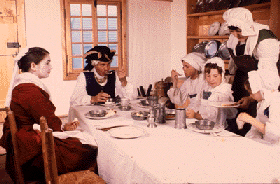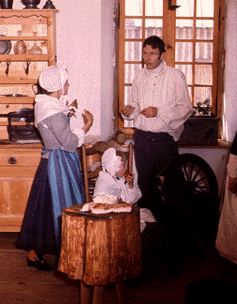
Family Life

The 18th century family was quite different from present day families in Canadian society. The families usually averaged four or five children. It was the material, social, and psychological institution of society. Besides providing food, shelter; the family functioned as a school, church, business, and welfare institution.
 Due to the lack of accommodations during hostile times, extended families were the norm. In-laws, domestic servants or slaves would live at the same residence as the immediate family. Building a house for a young couple and providing some livestock was often the custom for the community. In a number of marriage contracts, the parents promised to provide accommodations and also to feed the newlyweds at their table. In some cases, the young couple might live with the parents and take over the property in return for supporting them the rest of their lives. Nevertheless, it was common practice for fathers to offer free room and board for one or more years as part of his daughter's dowry. Many other parents of lower social status, informally welcomed their newlywed children into their homes without a written agreement in the marriage contract. An invitation of the young couple into their home was not so much a sacrifice of privacy as a workable compromise in living arrangements.
Due to the lack of accommodations during hostile times, extended families were the norm. In-laws, domestic servants or slaves would live at the same residence as the immediate family. Building a house for a young couple and providing some livestock was often the custom for the community. In a number of marriage contracts, the parents promised to provide accommodations and also to feed the newlyweds at their table. In some cases, the young couple might live with the parents and take over the property in return for supporting them the rest of their lives. Nevertheless, it was common practice for fathers to offer free room and board for one or more years as part of his daughter's dowry. Many other parents of lower social status, informally welcomed their newlywed children into their homes without a written agreement in the marriage contract. An invitation of the young couple into their home was not so much a sacrifice of privacy as a workable compromise in living arrangements.
Some married couples were given a separate room, completely furnished, in a parent's home. In other homes, there were internal divisions created by movable walls. Wealthy parents could partition off many rooms and still retain an acceptable standard of privacy. Heavy serge curtain hangings for beds provided some privacy for those who could afford this. A typical alternative, thin board partitions provided only little privacy.
 Furniture and household items were relatively expensive since they were imported from France and New England. Therefore, they were not to be discarded when worn or broken. Practical pieces of furniture included folding tables, straw and cane chairs since they were portable and easily stored. A flat-topped chest functioned not only as a bureau for clothes but as a seat or table. Tapestries were used as wall hangings, carpets, tablecloths, and blankets. Mattresses and fabrics could have also functioned as blankets. The portability of lightweight feather mattresses were useful. During the cold months, sleeping in a room near a fire was one means of keeping warm. Many households in Louisbourg had a brick or iron stove. Many families shared items such as eating utensils, table napkins, furniture, and bedclothes.
Furniture and household items were relatively expensive since they were imported from France and New England. Therefore, they were not to be discarded when worn or broken. Practical pieces of furniture included folding tables, straw and cane chairs since they were portable and easily stored. A flat-topped chest functioned not only as a bureau for clothes but as a seat or table. Tapestries were used as wall hangings, carpets, tablecloths, and blankets. Mattresses and fabrics could have also functioned as blankets. The portability of lightweight feather mattresses were useful. During the cold months, sleeping in a room near a fire was one means of keeping warm. Many households in Louisbourg had a brick or iron stove. Many families shared items such as eating utensils, table napkins, furniture, and bedclothes.
In conclusion, 18th-century family life was very different from our households in modern Canadian society. Extended families were the norm in a society filled with exile, war and famine. What similarities to the 18th century family exist in your culture today?


